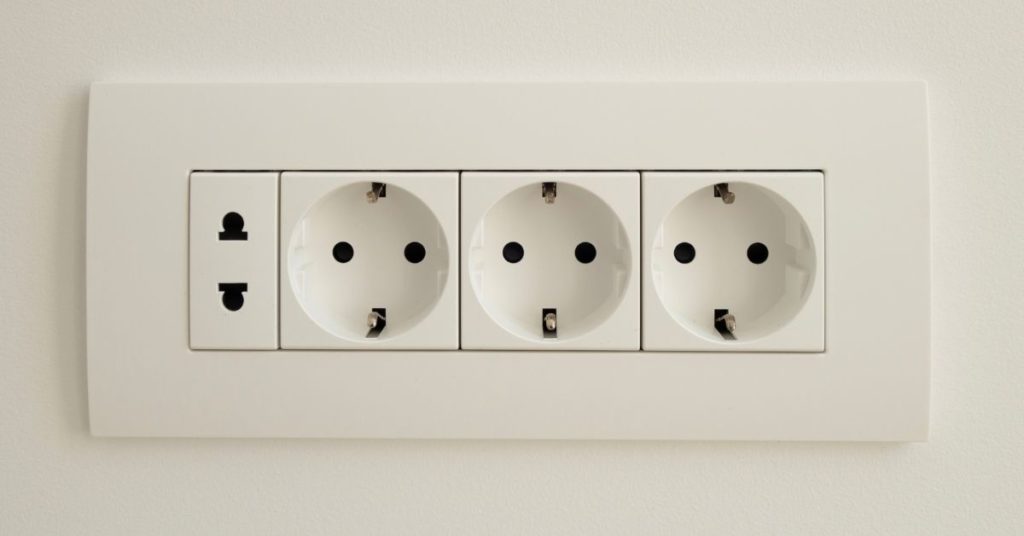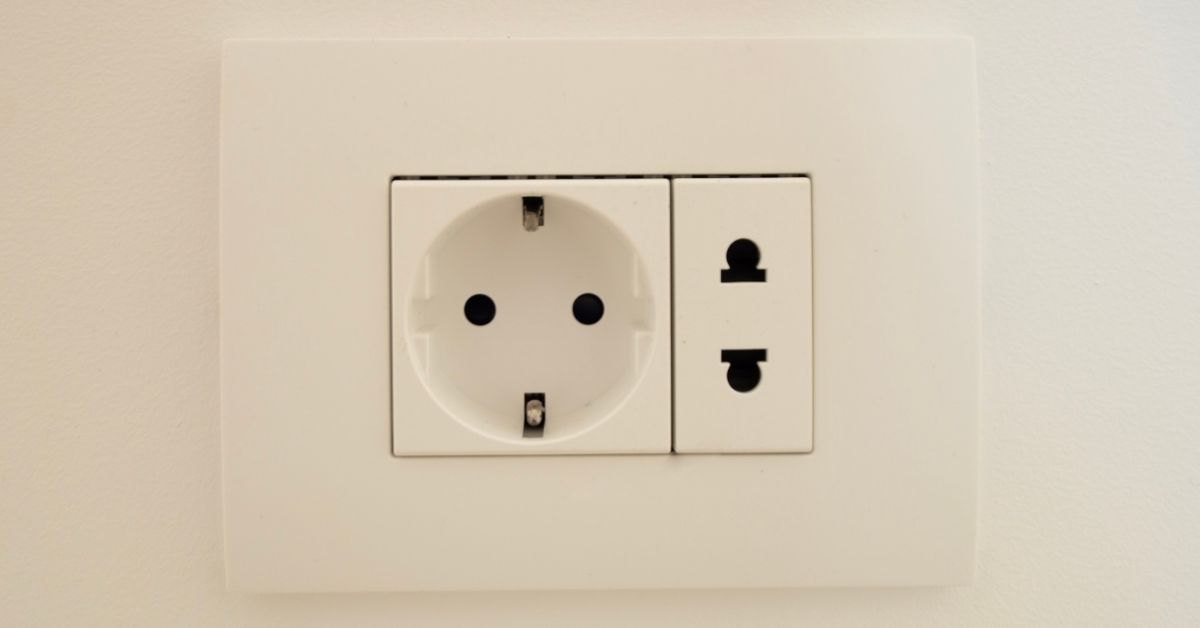A lot of people spend a lot of time dissecting the 110V VS 220V debate. But what about 110 VS 120V? Do 110V outlets differ from 120V outlets?
7 Major Differences Between 110 VS 120v Outlet?
1). Both Have Similar Design
Most 110v outlets have the same design. Some of them have two verticle slots on either side. Others have two verticle slots on either side as well as a third semicircular slot that is positioned in such a way that the three slots form a triangle.
The exact number of slots will depend on whether you have a Type A outlet (which doesn’t have a ground pin) or a Type B outlet (which has a ground pin). 110v outlets may vary in appearance depending on whether you have a 20Amp grounded outlet or a 15Amp grounded outlet.
If you look at the diagrams that P.C. Richard and Son has published, you will realize that the 20Amp outlet has a horizontal pin. You have to match the plug of your appliance to the right outlet, be it 15 or 20 Amps.
After looking at those diagrams, you might be tempted to conclude that the configuration of a 120v outlet is different. But the diagrams of a 120v outlet that Kiln Frog has published are exactly the same as the diagrams of the 110v outlets. You can find 120v outlets in 15 and 20A formats as well. The 20A 120v outlet has a horizontal pin.
In other words, you cannot differentiate between 110v and 120v outlets by their design. Both outlets look the same.
2). Price is Almost Same
110v outlets are the same as 120v outlets. As such, their prices do not differ. You can get a standard 120v outlet for $3-$5. And a standard 120v outlet can operate 110v devices.
In fact, a 120v outlet is designed to handle a voltage ranging from 110 to 120v. In other words, a standard 120v outlet also works as a 115v outlet. The price tag may rise to $22 in the case of outlets with USB ports. The number of prongs will also affect the price.
Naturally, three-prong outlets are slightly more expensive than two-prong outlets. But the voltage (110 VS 120) won’t make a difference. If you’re objective was to use the price difference to tell them apart, you will be sorely disappointed.
3). Both Are Dangerous
Many people argue that 110v is safer than 220v because it exposes the body to fewer volts. However, that doesn’t make 110v power supplies harmless. 110v can kill you just as effectively as 220v, especially if the current cuts across your heart.
When it comes to the danger they pose, every professional electrician you talk to will tell you that the difference between 110 and 120v is too small to matter. Even though 120v is higher, it is not necessarily more dangerous than 110v. You cannot use this criterion to differentiate between the two.
110v can kill you just as easily as 120v.
4). Both Are Used in North And South American Countries
110v and 120v power supplies are prominent in North American and South American countries. You will find them in the US, Canada, Mexico, Cuba, and Barbados. You will also find 110/120v in Honduras, Belize, the Bahamas, Nicaragua, Puerto Rico, and Costa Rica, to mention but a few.
If you want to know where your country falls, Power Stream has an extensive list that reveals the voltage and plug styles used in various countries. Most people know that many European countries use 240 volts whereas the US prefers 110/120.
5). Both Support Similar Devices
A lot of people do not realize that 110 and 120v are the same. They do not understand that the 110 vs 120v debate is unnecessary because the differences between 110v and 120v are not strong enough to affect the kinds of devices you can use.
The average power company in the US supplies 120v to residential locations. An American home has two 120v lines supplying power to the service panel. But because of the resistance in the wiring, that 120V will fall to 115V by the time it reaches the outlet in your home.
If you have an extension cord connected to that outlet, you will find that the voltage in the outlets of the extension cord is as low as 110v. Simply put, the voltage in your home may range from 110v to 125v. The power company knows this. They also know that any appliance that can run on 120v can also run on 110v.
6). Pros and Cons
A 110v power supply is the same as a 120v power supply. The terms are used interchangeably because the difference between them is too small to matter. It is better to compare 110v to 220v.
110v is often commended for being safer. It can still shock careless consumers but it is less likely to result in death than 220v. 110v also requires thinner cables. The Guardian doesn’t expect you to lose as much energy through heat. But you cannot use those factors in a 110 vs 120v debate because the differences are minimal.
120v is just as dangerous as 110v. It will cost the same. You can expect to lose the same amount of energy through heat. Additionally, the same appliances that run on 110v can run on 120v.
7). The Best Amongst These Two
Neither option is better than the other. When people say 110v and 120v, they are basically talking about the same thing. 110v doesn’t have any advantages that make it better than 120v. The reverse is also true. 120v is not superior to 110v. They are the same.
Are 110 and 120 Outlets The Same?
110 and 120-volt outlets are the same. They look the same and they work the same way. An appliance that can enter a 110v outlet will also enter a 120v outlet. You won’t find any physical attributes in a 110v outlet that set it apart from a 120v outlet. This is true for 115v as well.
How Do I Know If I Have a 110 or 120v Outlet?
You can identify a 110v outlet by its appearance. A 110v outlet has verticle slots on either side. If the outlet is designed to support three-prong plugs, it will also feature a third semicircular prong. A 120v outlet has the same design.

If you want a more definitive method for identifying the two, you can measure the voltage of the outlet with a multimeter.
Insert the probes of the multimeter into each slot. If you have a 110 or 120v outlet, Multimeter shows a reading ranging from 110 to 120v.
The final figure might be slightly higher or slightly lower. But if it is within that range, you can comfortably conclude that your outlets are 110/120v. If the multimeter has refused to show any readings, you may have a wiring problem.
What you have to understand is this: it won’t make any difference to your retailer whether you ask for a 110 or 120v outlet. They will sell you the same thing.
Can I Use 110v in a 120v Outlet?
You can use a 110v appliance in a 120v outlet. The differences between 110 and 120v are too small to matter. If your power supply has a rating of 120v, it actually has a range of 110 to 125v. Any appliance whose rating falls within that range can work on both 110v and 120v outlets.
Can I Use 120v In A 110v Outlet?
An appliance with a rating of 120v can work in a 110v outlet. The ratings of appliances are never as precise as their labels suggest. They can handle fluctuations of up to 10 percent in the voltage.
If a home has a 120v power supply, the voltage may fall as low as 108v or rise as high as 132v depending on the situation. And an appliance with a rating of 120v can work comfortably within that range.
Some appliances are a little too sensitive and they may become hotter than normal because they are pulling more amps. But they will still work. The practise won’t attract any catastrophic consequences.
Are US Outlets 110 or 120V?
The standard voltage in the US is 120v (60Hz AC). 120v will enter the average American home on a single hot wire. But because of the resistance, the voltage may drop before it reaches your outlets and appliances.
In other words, if you look at your service panel, it will tell you that your home has a 120v power supply. But if you measure the voltage in the outlet using a multimeter, it might be lower than 120v.

